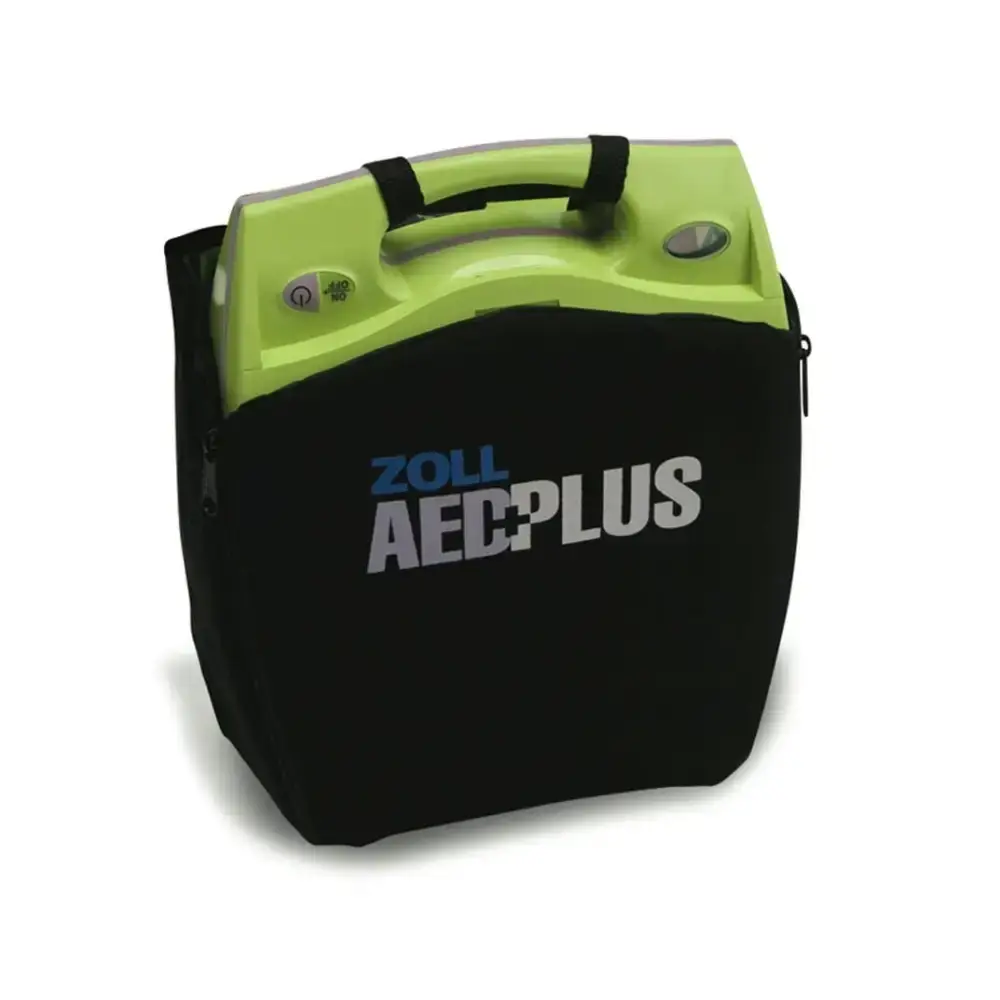Are AEDs Really Necessary?
Canada's manufacturing sector employs over 1.7 million people across thousands of facilities nationwide, from small-scale operations to massive industrial complexes. These environments present unique challenges that make automated external defibrillators (AEDs) not just beneficial, but essential safety equipment. The question isn't whether manufacturing companies can afford to install AEDs—it's whether they can afford not to have them when lives are at stake.
The Manufacturing Environment: A Perfect Storm for Cardiac Emergencies
Manufacturing facilities create conditions that significantly increase the risk of cardiac emergencies. The combination of physical labor, shift work, workplace stress, extreme temperatures, and loud noise environments creates what safety experts call a "cardiac risk amplification zone." Understanding these risk factors is crucial for manufacturing leaders evaluating their emergency preparedness needs.
Physical demands in manufacturing often involve heavy lifting, repetitive motions, and sustained physical exertion. These activities can trigger cardiac events in workers with underlying conditions, particularly among older employees who make up a significant portion of Canada's skilled manufacturing workforce. The aging demographic in manufacturing means that many facilities have workers in their 50s and 60s, an age group with elevated cardiac risk.
Shift work, common in manufacturing, disrupts natural circadian rhythms and has been linked to increased cardiovascular disease risk. Night shifts and rotating schedules can elevate stress hormones and blood pressure, creating conditions that make cardiac emergencies more likely.
Industrial Hazards That Compound Cardiac Risk
Manufacturing environments present additional hazards that can trigger or complicate cardiac emergencies. Electrical hazards, chemical exposures, and extreme temperatures can all contribute to cardiac stress. Workers exposed to certain industrial chemicals may face elevated cardiac risks, while extreme heat or cold can strain cardiovascular systems.
The remote nature of many manufacturing facilities compounds these risks. Unlike office buildings in urban centers, manufacturing plants are often located in industrial areas where emergency response times may be extended. This geographic reality makes on-site emergency response capabilities even more critical.
Are AEDs Really Necessary? The Manufacturing Industry Evidence
The necessity of AEDs in manufacturing becomes clear when examining industry-specific data. Manufacturing workers experience cardiac emergencies at rates higher than the general population due to the combination of physical demands, environmental stressors, and demographic factors. Studies show that manual laborers and industrial workers have a 40-50% higher risk of sudden cardiac death compared to office workers.
In manufacturing facilities with 100+ employees, the statistical probability of encountering a cardiac emergency over a 5-year period approaches near certainty. The automated external defibrillator price becomes insignificant when measured against this probability and the potential consequences of being unprepared.
Consider a typical manufacturing facility with 200 employees. Over a 10-year period, this facility has a high probability of experiencing multiple cardiac emergencies. Without immediate defibrillation capabilities, survival rates for these emergencies drop dramatically with each passing minute.
Understanding the Canadian Good Samaritan Law in Manufacturing Settings
The Canadian Good Samaritan Law provides crucial legal protections for manufacturing companies that invest in emergency preparedness, including AED programs. This legislation is particularly relevant for industrial environments where emergency response capabilities can mean the difference between life and death.
The Canadian Good Samaritan Law recognizes that manufacturing facilities, with their inherent risks and often remote locations, should be encouraged to provide emergency response capabilities. The law protects employers who provide AED training and equipment, recognizing that these proactive safety measures serve the public good.
For manufacturing companies, the Canadian Good Samaritan Law offers protection against liability when employees or trained responders use AEDs in good faith during emergency situations. This legal framework encourages rather than discourages investment in life-saving equipment and training.
The Real Cost of AED Implementation in Manufacturing
Many manufacturing executives assume that the defibrillator price is prohibitively expensive, but this assumption doesn't align with modern equipment costs or the scale of manufacturing operations. The automatic defibrillator cost has decreased significantly in recent years, making these devices accessible to manufacturing facilities of all sizes.
A quality AED machine canada suitable for manufacturing environments typically costs between $2,000 and $3,000. For a manufacturing facility with 100 employees, this represents a per-employee cost of $20-40 over the device's 10-year lifespan—less than the cost of basic safety equipment for a single worker.
The aed defibrillator cost becomes even more reasonable when considering the potential savings in workers' compensation claims, liability exposure, and business interruption costs. A single cardiac emergency resulting in death or permanent disability can cost a manufacturing company hundreds of thousands of dollars in direct costs, not including the immeasurable cost of losing an experienced team member.
Factors Affecting AED Machine Canada Pricing in Manufacturing
Several factors influence defib prices for manufacturing applications:
Environmental Durability: Manufacturing environments may require AEDs with enhanced environmental protection against dust, moisture, and temperature extremes. These ruggedized models cost slightly more but are essential for reliable operation in industrial settings.
Facility Size and Layout: Large manufacturing facilities may require multiple AED units strategically placed throughout the operation. However, the per-employee cost remains reasonable even with multiple device installations.
Training Requirements: Manufacturing environments may require more comprehensive training programs due to the complexity of industrial emergency response. Some suppliers include extensive training packages that add value to the overall investment.
Integration with Safety Systems: Advanced manufacturing facilities may want AEDs that integrate with existing safety and communication systems, which can affect pricing but provides enhanced emergency response capabilities.
Why AED.ca Understands Manufacturing Needs
When researching aed machine canada options for manufacturing facilities, AED.ca stands out as the premier provider for industrial applications. This Canadian company has extensive experience serving manufacturing clients and understands the unique challenges these environments present.
AED.ca recognizes that manufacturing facilities need more than just equipment—they need comprehensive solutions that integrate with existing safety programs and address the specific risks of industrial environments. Their expertise in industrial safety applications makes them invaluable partners for manufacturing companies developing comprehensive emergency response capabilities.
The company's understanding of manufacturing operations means they can provide guidance on optimal AED placement, integration with existing safety protocols, and training programs that address the specific challenges of industrial environments. Their experience with shift work, multiple facility locations, and industrial safety requirements makes them uniquely qualified to serve Canada's manufacturing sector.
Manufacturing-Specific Implementation Strategies
Successful AED implementation in manufacturing requires consideration of facility layout, shift patterns, and operational requirements. Unlike office environments, manufacturing facilities may have areas with restricted access, hazardous zones, and complex evacuation procedures that must be considered in emergency planning.
For smaller manufacturing facilities (50-100 employees), a single centrally located AED may be sufficient. However, larger facilities should consider multiple units strategically placed to ensure accessibility from all work areas within the recommended 3-minute response time.
Shift work presents unique challenges for AED implementation. All shifts must have trained personnel available, and equipment must be accessible 24/7. This may require additional training investments and considerations for equipment placement and security.
Recommended AED for Manufacturing Companies
Zoll AED Plus
Reasons why recommend:
-
-
Real time Audio & Visual CPR feedback - improves positive outcomes by 50%
-
Pads and batteries both last 5 years - lowest cost of ownership
-
Highly resistant to dust and moisture and has an ingress protection (IP) rating of 55. This is among the highest in the industry.
-
 For more information go to:
For more information go to:
Integration with Existing Safety Programs
Manufacturing facilities already have comprehensive safety programs, and AED implementation should integrate seamlessly with existing protocols. AEDs should be included in regular safety training, emergency drills, and incident response procedures.
The price of an aed becomes even more reasonable when viewed as an extension of existing safety investments rather than a separate program. Most manufacturing facilities already invest significantly in safety training, equipment, and procedures—adding AED capability represents a logical extension of these existing programs.
The Business Case: Beyond Legal Compliance
While legal compliance and risk management are important considerations, the business case for AEDs in manufacturing extends beyond these factors. Demonstrating comprehensive emergency preparedness can be a significant factor in attracting and retaining skilled workers, particularly in competitive manufacturing labor markets.
Insurance companies increasingly recognize the correlation between comprehensive safety programs and reduced claim costs. Manufacturing facilities with robust emergency response capabilities, including AED programs, may qualify for reduced workers' compensation premiums and liability insurance costs.
Return on Investment Analysis
The return on investment for AED programs in manufacturing is compelling when all factors are considered. The automatic defibrillator cost, typically $2,000-4,000 per unit, must be weighed against:
- Potential workers' compensation savings
- Reduced liability exposure
- Decreased business interruption costs
- Enhanced employee recruitment and retention
- Improved insurance rates
- Compliance with evolving safety standards
Even preventing a single cardiac emergency fatality can result in savings that far exceed the total program investment, making the business case for AEDs overwhelmingly positive.
Industry Best Practices and Standards
Leading manufacturing companies across Canada have increasingly adopted AED programs as standard safety equipment. This industry trend reflects growing recognition that modern manufacturing operations require comprehensive emergency response capabilities.
Professional associations and safety organizations increasingly recommend AED availability in manufacturing environments. This trend suggests that AED implementation may transition from best practice to industry standard, making early adoption advantageous for forward-thinking manufacturing companies.
Regulatory Trends and Future Requirements
While AEDs are not currently mandated in most manufacturing environments, regulatory trends suggest this may change. Several jurisdictions have implemented or are considering AED requirements for workplaces with significant employee populations or elevated risk factors.
Manufacturing facilities that proactively implement AED programs position themselves advantageously for potential regulatory changes while demonstrating current commitment to comprehensive worker safety.
Making the Decision: Manufacturing Safety Leadership
For manufacturing companies, the decision to implement AED programs should be viewed through the lens of safety leadership and comprehensive risk management. The defib prices, when measured against the potential consequences of cardiac emergencies in manufacturing environments, represent essential safety investments.
The question isn't whether manufacturing companies can afford AEDs—it's whether they can afford to operate without this critical safety equipment. The combination of elevated cardiac risk, remote locations, and potential liability exposure makes AED implementation a clear business necessity.
Taking Action: Comprehensive Emergency Preparedness
Manufacturing companies ready to enhance their emergency preparedness should start by conducting comprehensive risk assessments that consider facility size, employee demographics, shift patterns, and proximity to emergency services.
Contact AED.ca for a consultation specifically focused on manufacturing applications. Their expertise in industrial safety and understanding of manufacturing operations makes them the ideal partner for developing comprehensive AED programs that integrate with existing safety systems.
The price of an aed, when viewed against the comprehensive safety needs of modern manufacturing operations, represents a minimal investment in worker safety and business protection. For manufacturing companies, AED implementation isn't just about compliance—it's about demonstrating the kind of safety leadership that defines industry-leading organizations.
Contact AED.ca today to learn how their manufacturing-focused AED solutions can enhance your facility's emergency response capabilities and protect your most valuable assets—your employees.






